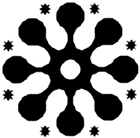 Clicking
on an image will open another window. You can use the second window
to scroll through all the enlarged images associated with this article
Clicking
on an image will open another window. You can use the second window
to scroll through all the enlarged images associated with this article |
The Henna Page Journal |
|
An Amazigh woman was repeatedly ornamented with henna during the seven days after birth, as well as having her eyes rimmed with kohl. She was kept secluded, and only the midwife was allowed to attend her behind her curtain. This was seen as a safeguarding the mother against malicious spirits and witchcraft that would cause her illness, depression and death (Westermarck II, 1926, 385). The effect of these ritual actions was to allow the mother to rest and be cared for by an experienced attendant during the 10 day period required for her estrogen, progesterone and prolactin levels to stabilize and for her to recover her strength (Stern and Kruckman 1983), as well as being comforted by ritual actions familiar from her wedding. Neither mother nor child were washed with water during this period, but were cleaned with oil and henna. At each application of henna, the woman would have to remain still for several hours, resting, and allowing others to take care of household tasks, ensuring that she would regain her strength quickly. On the seventh day after birth, the child was washed and named. A Bishmillah[2] was spoken, the child’s name announced, along with the parent’s names, so that if a child died in infancy it could find its parents in the afterlife. If the child was a son, a ram was slaughtered in its honor, and the child’s name was spoken at the moment of sacrifice. A feast was prepared for the mother and child and the mother’s secluding curtain would be opened. In Andjra, the midwife again adorned the mother with henna, and dressed her in clean clothing. The child was also hennaed on the head, neck, navel, feet and fingernails, in its armpits and between the legs, all in an effort to avert malicious spirits. The mother was dressed with slippers on her feet, and her head was covered, leaving only eyes, nose and mouth uncovered, so that witchcraft or malicious spirits would not cause her mental or physical illness. The mother still abstained from work at this time, though she directed household tasks. Women in the house trilled a zgrit several times at the birth of a son, fewer at the birth of a daughter (Westermarck II, 1926: 386 – 94) to dispel evil spirits.
At the seventh day and days following, the family put on as extensive celebration as could be afforded. Female relatives who visited during this period assisted household tasks so the mother could continue to rest. Music and feasting was arranged to celebrate the birth, and the mother was dressed in fine clothing, hennaed, harquuesed, her hair dressed in fragrant oil and rosewater as if she were a bride. She was given the heart and fat of the sacrificed animal to eat (Westermarck II 1926: 397), one of the few times that a woman was guaranteed abundant calories and protein. Again, elaborate henna ensured that the mother would rest for several hours during and after the application. She would be excused from household chores for the following weeks to keep her henna stains beautiful, so the henna encouraged continued rest and recovery. |
|
|
|||
| [Home] [How] [Why] [What] [Where] [FAQ] [Forum] | |||


